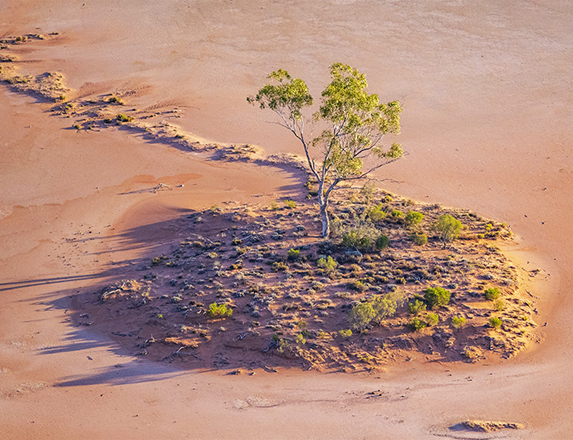A vast property spanning nearly 34,000 hectares has officially become a new NSW national park … and it seems camping opportunities may not be too far away.
Minister for Environment, James Griffin, said the Brindingabba National Park, 175 kilometres north-west of Bourke, would now be protected in perpetuity, and visitors would be able to experience it for themselves for generations to come
“The new Brindingabba National Park protects an important part of Lake Wombah and more than 7,000 hectares of Yantabulla Swamp, which are nationally important wetlands,” he said. “The 33,903-hectare park supports 30 different ecosystems, protecting habitat for at least 12 endangered and 31 vulnerable species.”

The new Brindingabba National Park boasts nationally important wetlands. PIC: DPE
Located in the traditional Paroo River country of the Budjiti and Barkandji People on the NSW-Queensland border, the property has extensive Aboriginal cultural heritage, with evidence of artefacts and other items of significance across the property.
It is expected the new park will open to the public before the end of next year.
The National Parks and Wildlife Service has commenced management on the property and plans to build facilities to support opportunities to camp and explore the area.
The NSW Government says the park will boost the Outback economy, providing an important new visitor destination as part of a strategy to help diversify regional economies.
NSW national parks contribute almost $18 billion in economic output for the state, delivering significant economic benefits for the regions.
I often camp in National Parks. They tend to be less crowded than caravan parks and you feel your a part of the surrounding ecosystem. A drop dunny is good. The new ones are better than the water loos in my opinion.
Good signage with history is great even down to the plants in the area. Well signposted tracks are good to if feasible. Employment of indigenous people to take care of country and facilities essential in my opinion.
We travel with our elderly cat so no national parks for us.
Are dogs on leads/ strollers allowed?
National Parks are primarily the domain of wildlife and flora conservation they are not fun parks for humans.
We are guests there, subject to rules which are generally refrain us from interference.
Dogs/cats are not allowed.
We utilise National Parks regularly. We really enjoy the remote areas and the geographical and other features they provide. In addition we appreciate the no domestic animal, no generators chainsaws etc. We trust this never changes.
Responsible pet owners should be allowed into parks. Parks are supposedly for public use. The ban on pets is an unfair restriction on travellers seeking to enjoy our beautiful country and an economic loss to the areas and would also provide needed funding to maintain the parks and control the feral and weed problems.
I disagree. The cat has decimated Australia’s small fauna and wild dogs (not dingos) are a common issue throughout national parks and reserves across australia whose owners have ‘lost’ them while walking off lead.
In addition, native fauna can smell the urine of a cat or dog where it has been and this scares them away (see above…did I mention the cat and decimating).
From a relaxation point of view, the last thing campers need to others calling out for their cat or dog that has strayed away and dogs barking at every kangaroo they see. Give that a big miss thanks.
We utilize national parks in our travels all over Australia and appreciate the ban on domestic pets. Love the parks that have flora and fauna info boards. Looking forward to this one.